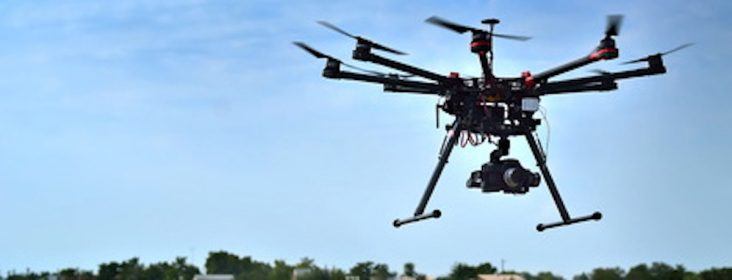Consumers weigh in on drone delivery, more than half surveyed find it ‘very appealing’
by January 19, 2017 5:54 pm 551 views

Flying with a drone for video and photo productions
7-Eleven, partnering with U.S. drone delivery service Flirtey, recently announced the completion of 77 deliveries from 7-Eleven to customers’ homes toting items like flu meds and hot coffee. They are believed to be the first from any retailer in the U.S.
Drone delivery already available in the United Kingdom is still a novelty in the United States as more stringent federal regulations have kept it in a testing phase by retailers like Walmart and Amazon.
Amazon CEO Jeff Bezos has expressed frustrations with the slow pace of the Federal Aviation Authority. Amazon applied for a permit to fly drones in the U.S. in 2014. But then the company said it took a year it to get the testing permit and in the meantime it turned its sights to the United Kingdom, where it recently completed a drone delivery. The online retailer said the permit it received in the U.K. allows it to fly drones in some rural areas and suburban areas in the U.K., allowing the company to test more freely.
Annibal Sodero, assistant professor of supply chain analytics at the University of Arkansas, recently told Talk Business & Politics the U.K. is a good testing ground for Amazon to work out any kinks and gain proficiency in drone delivery so that when and if the FAA relaxes the rules they can have a first mover advantage in the U.S.
The FAA has issued nearly 300 commercial drone flight waivers to retailers, cities, restaurants, other businesses and logistics companies such as United Parcel Service. UPS also recently reported it used drone technology to make a medical drop to Martha’s Vineyard, Mass.
Wal-Mart continues to test the use of drones in its stores and warehouses but has not yet used the technology for customer deliveries.
As drone permits continue to escalate in the U.S., it’s just a matter of time before consumers will likely have that delivery option in some areas of the country. Fayetteville-based Field Agent recently conducted a poll to gather consumer attitudes about drone delivery. The survey of more than 2,000 consumers, ages 18 to 65 indicate a wide acceptance of the emerging delivery technology. Half of the respondents were men and the geographic location of the respondents were split between smaller populated areas below 50,000 (39%) to median-size areas up to 500,000 people (39%), and very large areas with more than 500,000 people (22%).
Over half (54%) said drone delivery was extremely or very appealing, about one-third said it’s moderately appealing and the remaining 16% were really not very interested. Drone delivery can be used for a wide range of products but the two reasons the majority of consumers would like to see delivery is sending gifts to others (57%) and delivering hot, ready-to-eat meals to themselves (56%). Half of the respondents see the drones as good delivery service for entertainment such as books and DVDs.
There also is the niche use for medical and health products which is important to an aging population according to 48% of the respondents. Snacks and groceries were also popular choices for drone delivery by about 45% of those surveyed. Apparel and electronic accessories were choices by 41% of the respondents. Fresh groceries were not as popular with 36% citing that. Baby supplies and beauty products were less popular at 22% and 29%, respectively.
Consumers see drone delivery as a way to get items faster, as 75% of the respondents expect delivery within one hour or less, But 44% want it faster in 30 minutes or less. Despite wanting the fast service, consumers aren’t willing to pay much for it. When asked what the highest fee they would accept for delivery of merchandise for items valued at $5, $20 and $100, consumers were willing to pay a larger percentage for the cheapest order. The most commonly used response for the $5 order was $1 which is a 20% overall cost increase. For the $20 order the mode answer was $5 equal to a 25% cost increase. But for the most expensive item of $100, consumers would most likely pay $10, which is just a 10% cost increase. In fact, 58% of the consumers surveyed expressed concerns over the price for the drone delivery.
While cost matters, 63% of consumers said the safety of the packages was their biggest concern. Over half the consumers were also concerned with technological malfunctions, shipping mistakes, human interference and package condition. Just under half the respondents see potential issues with weather, limited carrying capacity, privacy, general safety and interference with air traffic.
Consumers, according to survey results, believe drone delivery could have significant benefits for faster delivery, serving shut-ins, urgent non-medical products, relieving traffic congestion and assisting with health emergencies.
While many retailers have permits to test the technology, consumers were asked which ones they believe will offer it as a delivery option in the future. Overwhelmingly, 82% cite Amazon, while 65% believe Wal-Mart will also figure out how to use it. Target was third at 59% and 7-Eleven, the first to do it the U.S. only, garnered 15%.
Domino’s, McDonald’s and Chipotle were the three restaurants cited in the report by consumers. Drugstore chains Walgreens and CVS also made the list.
Just under half (43.3%) of those surveyed said they would very likely use drone delivery in the future. Another 30.7% said they were moderately likely to do so. About 15% have little or no plans to use it when it becomes available to them.
